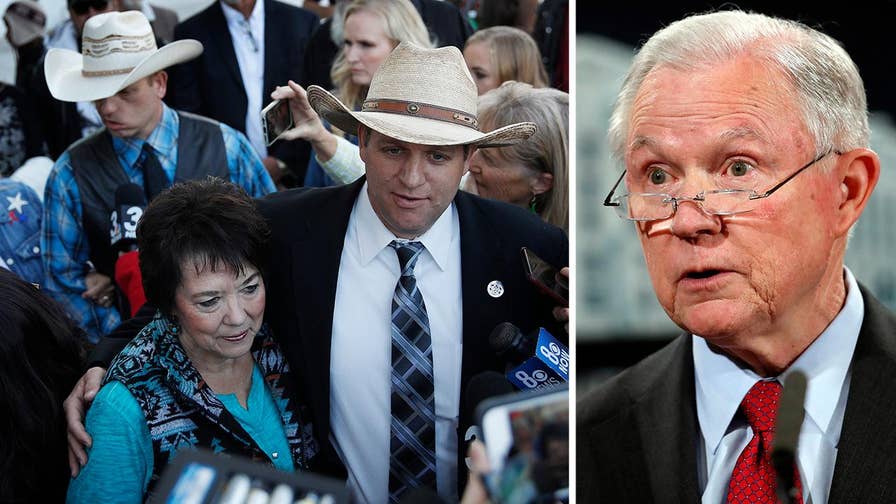The embarrassment a federal judge dealt to government prosecutors last month in the Cliven Bundy case could be set to resume Monday, at a hearing to determine whether the cattle rancher who became a folk hero long before he beat the feds can be retried.
U.S. District Judge Gloria Navarro on Dec. 20 declared a mistrial in the high-profile case. It was only the latest, stunning development in the saga of the Nevada rancher, and served as a repudiation of the federal government. Navarro accused prosecutors of willfully withholding evidence from Bundy’s lawyers, in violation of the federal Brady rule.
The Brady rule, named after the landmark 1963 Supreme Court case known as Brady v. Maryland, holds that failure to disclose such evidence violates a defendant’s right to due process.
“Either the government lied or [it’s actions were] so grossly negligent as to be tantamount to lying."
“In this case the failures to comply with Brady were exquisite, extraordinary,” said Fox News legal analyst Judge Andrew Napolitano. “The judge exercised tremendous patience.”
The 71-year-old Bundy’s battle with the federal government eventually led to what became known as the Bundy standoff of 2014. But it began long before that.
In the early 1990s, the U.S. government limited grazing rights on federal lands in order to protect the desert tortoise habitat. In 1993, Bundy, in protest, refused to renew his permit for cattle grazing, and continued grazing his livestock on these public lands. He didn’t recognize the authority of the Bureau of Land Management (BLM) over the sovereign state of Nevada.
The federal courts sided with the BLM, and Bundy didn’t seem to have a legal leg to stand on. Nevertheless, the rancher and the government continued this dispute for 20 years, and Bundy ended up owing over $1 million in fees and fines.

To many, Bundy is a folk hero who stood up to the federal government (Associated Press)
Things came to a head in 2014, when officials planned to capture and impound cattle trespassing on government land. Protesters, many armed, tried to block the authorities, which led to a standoff. For a time, they even shut down a portion of I-15, the main interstate highway running through Southern Nevada.
Tensions escalated until officials, fearing for the general safety, announced they would return Bundy’s cattle and suspend the roundup.
Afterward, Bundy continued to graze his cattle and not pay fees. He and his fellow protesters were heroes to some, but criminals to the federal government. Bundy, along with others seen as leaders of the standoff, including sons Ammon and Ryan, were charged with numerous felonies, including conspiracy, assault on a federal officer and using a firearm in a violent crime. They faced many years in prison.
The Bundy case finally began in late October, 2017. But just two months later, it ended with Navarro angry, the feds humiliated and Bundy – at least to his supporters – vindicated.
In fact, Navarro had suspended the trial earlier and warned of a mistrial when prosecutors released information after a discovery deadline. Overall, the government was late in handing over more than 3,300 pages of documents. Further, some defense requests for information that ultimately came to light had been ridiculed by prosecutors as “fantastical” and a “fishing expedition.”
“Either the government lied or [it’s actions were] so grossly negligent as to be tantamount to lying,” Napolitano said. “This happened over and over again.”
Navarro offered a handful of examples of the prosecution’s failure to disclose. One had to do with a video showing government surveillance of the Bundy ranch, as well as government snipers, before the standoff.
“Timing is everything when it comes to these documents,” said Napolitano. “The tapes show that the defendants were telling the truth when they said they brought a militia to the property to protect them from snipers, rather than the government’s version, which is that the snipers came to protect the government agents from the militia.”
Other instances of the government holding back included the failure to produce an internal affairs report on BLM misconduct, which the defense requested and the government denied existed, and threat assessments by federal agents declaring the Bundys were not likely to use violence.
“The court does regrettably believe a mistrial in this case is the most suitable and only remedy,” Navarro said in declaring a mistrial.
On Monday, Navarro will decide whether to dismiss the case with or without prejudice. If it’s dismissed without prejudice, the prosecutors can charge Bundy with the same crimes.
It would be highly unusual for Navarro to dismiss a criminal case and not allow the government the option of another indictment, Napolitano said. However, although Navarro has already set a tentative date of late February to begin any new trial, the government can’t be too confident in the outcome. In addition to the problems with this case, there have also been a number of mistrials and acquittals in other cases related to the Bundy standoff.
“I wouldn’t be surprised if you have a lot of jurors whose hearts are with these characters just because they like the rugged individualism of the West versus an overreaching Bureau of Land Management,” Napolitano said.

